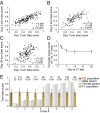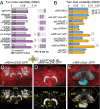Neuronal control of locomotor handedness in Drosophila
- PMID: 25953337
- PMCID: PMC4450378
- DOI: 10.1073/pnas.1500804112
Neuronal control of locomotor handedness in Drosophila
Abstract
Genetically identical individuals display variability in their physiology, morphology, and behaviors, even when reared in essentially identical environments, but there is little mechanistic understanding of the basis of such variation. Here, we investigated whether Drosophila melanogaster displays individual-to-individual variation in locomotor behaviors. We developed a new high-throughout platform capable of measuring the exploratory behavior of hundreds of individual flies simultaneously. With this approach, we find that, during exploratory walking, individual flies exhibit significant bias in their left vs. right locomotor choices, with some flies being strongly left biased or right biased. This idiosyncrasy was present in all genotypes examined, including wild-derived populations and inbred isogenic laboratory strains. The biases of individual flies persist for their lifetime and are nonheritable: i.e., mating two left-biased individuals does not yield left-biased progeny. This locomotor handedness is uncorrelated with other asymmetries, such as the handedness of gut twisting, leg-length asymmetry, and wing-folding preference. Using transgenics and mutants, we find that the magnitude of locomotor handedness is under the control of columnar neurons within the central complex, a brain region implicated in motor planning and execution. When these neurons are silenced, exploratory laterality increases, with more extreme leftiness and rightiness. This observation intriguingly implies that the brain may be able to dynamically regulate behavioral individuality.
Keywords: behavior; central complex; circuit mapping; individuality; personality.
Conflict of interest statement
The authors declare no conflict of interest.
Figures




Similar articles
-
Behavioral idiosyncrasy reveals genetic control of phenotypic variability.Proc Natl Acad Sci U S A. 2015 May 26;112(21):6706-11. doi: 10.1073/pnas.1503830112. Epub 2015 May 7. Proc Natl Acad Sci U S A. 2015. PMID: 25953335 Free PMC article.
-
Locomotor control by the central complex in Drosophila-An analysis of the tay bridge mutant.Dev Neurobiol. 2008 Jul;68(8):1046-58. doi: 10.1002/dneu.20643. Dev Neurobiol. 2008. PMID: 18446784
-
Neuropeptides in the Drosophila central complex in modulation of locomotor behavior.J Exp Biol. 2010 Jul 1;213(Pt 13):2256-65. doi: 10.1242/jeb.043190. J Exp Biol. 2010. PMID: 20543124
-
Systems neuroscience in Drosophila: Conceptual and technical advantages.Neuroscience. 2015 Jun 18;296:3-14. doi: 10.1016/j.neuroscience.2014.06.035. Epub 2014 Jun 25. Neuroscience. 2015. PMID: 24973655 Review.
-
Neuronal mechanisms regulating locomotion in adult Drosophila.J Neurosci Res. 2024 Apr;102(4):e25332. doi: 10.1002/jnr.25332. J Neurosci Res. 2024. PMID: 38646942 Review.
Cited by
-
Harmonic radar tracking of individual melon flies, Zeugodacus cucurbitae, in Hawaii: Determining movement parameters in cage and field settings.PLoS One. 2022 Nov 16;17(11):e0276987. doi: 10.1371/journal.pone.0276987. eCollection 2022. PLoS One. 2022. PMID: 36383542 Free PMC article.
-
Adaptation of Drosophila larva foraging in response to changes in food resources.Elife. 2022 Dec 2;11:e75826. doi: 10.7554/eLife.75826. Elife. 2022. PMID: 36458693 Free PMC article.
-
A conditional glutamatergic synaptic vesicle marker for Drosophila.G3 (Bethesda). 2022 Mar 4;12(3):jkab453. doi: 10.1093/g3journal/jkab453. G3 (Bethesda). 2022. PMID: 35100385 Free PMC article.
-
Sex-Specific Effects of Social Environment on Behaviour and Their Correlations in Drosophila melanogaster.Ecol Evol. 2025 Apr 25;15(4):e71261. doi: 10.1002/ece3.71261. eCollection 2025 Apr. Ecol Evol. 2025. PMID: 40290389 Free PMC article.
-
Stability of olfactory behavior syndromes in the Drosophila larva.Sci Rep. 2023 Feb 10;13(1):2398. doi: 10.1038/s41598-023-29523-x. Sci Rep. 2023. PMID: 36765192 Free PMC article.
References
-
- Souman JL, Frissen I, Sreenivasa MN, Ernst MO. Walking straight into circles. Curr Biol. 2009;19(18):1538–1542. - PubMed
Publication types
MeSH terms
LinkOut - more resources
Full Text Sources
Other Literature Sources
Molecular Biology Databases

